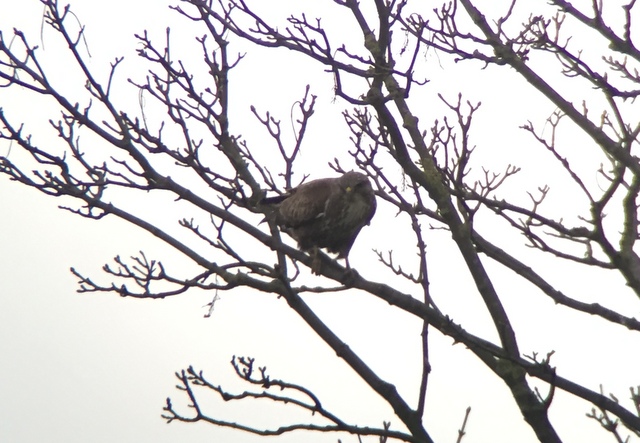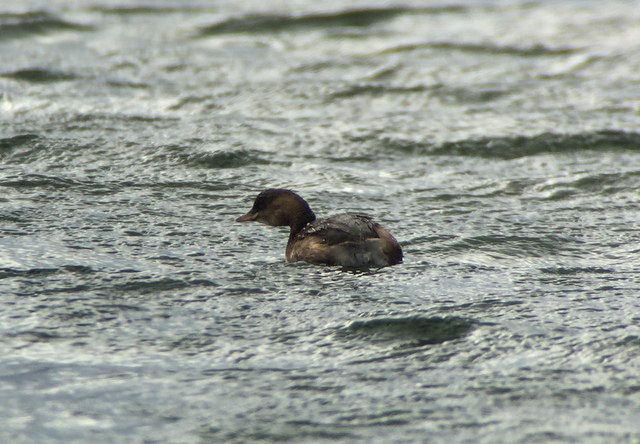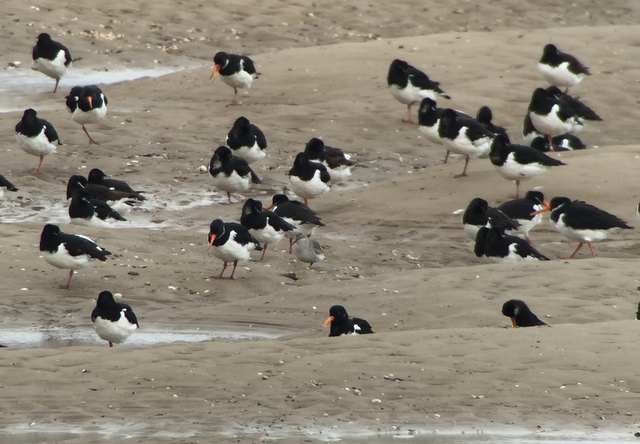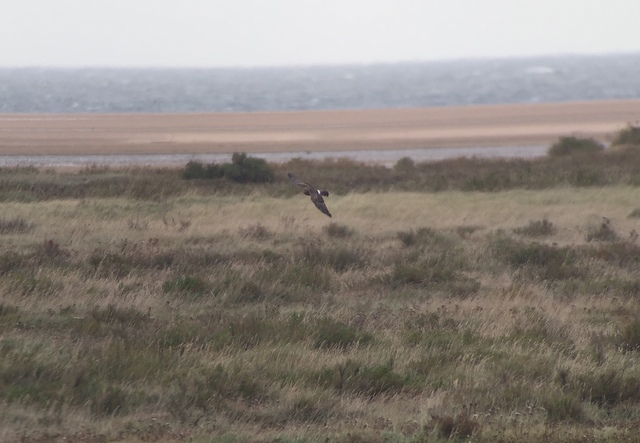Day 3 of a long weekend of tours today, the last day. It was forecast to be windy, and that was certainly the case, gusting up to 48mph at times. It was also forecast to be mostly dry, but once again the Met Office let us down! At least it was just showers, and most of them were light. Still, it is worth going birding in almost any weather, because you never know what might turn up – and today was a very good case in point, with a surprise in store at the end of the day…
We started at Holkham. There were a few Pink-footed Geese along Lady Anne’s Drive as is usual at this time of year, loafing around on the grazing marshes, so we stopped to get a good look at them in the scope. Conveniently, there were some Greylag Geese nearby for comparison. We could see the smaller size, darker head and smaller darker bill of the Pink-footed Geese. We could also see their pink legs, if not their feet. A little further over were some feral Egyptian Geese as well.
 Pink-footed Goose – we stopped to look at them along Lady Anne’s Drive
Pink-footed Goose – we stopped to look at them along Lady Anne’s Drive
There was a big flock of Wigeon out by the pools along the road as well, along with a few Teal and Mallard. A few raptors were even braving the wind – a couple of Marsh Harriers circling distantly and a Common Buzzard hanging on the wind over towards Wells. A second Common Buzzard was more sensibly perched in a tree nearby.
 Common Buzzard – perched in the trees by Lady Anne’s Drive this morning
Common Buzzard – perched in the trees by Lady Anne’s Drive this morning
We parked down at the north end – there were not so many cars there this morning – and walked out through the pines towards the beach. It was more sheltered on the north side of the trees and we could hear Coal Tits calling as we walked. There were several tiny Goldcrests feeding down low in the brambles by the path and we paused to watch one just in front of us – the UK’s smallest native bird, it was probably a struggle for them to find food in the conditions this morning.
We walked out across the saltmarsh and flushed a Rock Pipit from beside the path, which flew off calling. Several Skylarks also took off as we passed. There was a small party of about 20 Brent Geese feeding nearby, so we stopped to have a quick look at them. One was subtly different – a fraction darker on the back and belly, with a slightly whiter flank patch and collar – but it was not as striking as a Black Brant, like the one we had seen the other day. This was a Black Brant hybrid or intergrade – the offspring of a Black Brant which had paired with one of our more typical Dark-bellied Brent Geese several years ago. Brent Geese are remarkably site faithful, often returning to exactly the same place every winter. This Black Brant hybrid is a regular in these parts, so it was nice to see it back here again.
 Black Brant hybrid – among the Dark-bellied Brent Geese
Black Brant hybrid – among the Dark-bellied Brent Geese
We watched them for a while, and the Black Brant hybrid reacted aggressively when any of the other geese got too close. It gradually became clear it was part of small family group, paired to a regular Dark-bellied Brent Goose and with a couple of juveniles in tow. It would be interesting to see what these birds look like when they are grown up, but it seems likely that they are largely indistinguishable from normal Dark-bellied Brents, which can be rather variable in appearance themselves anyway.
Out on the beach, we found some shelter in the lee of the dunes and scanned the sea. It was much rougher than yesterday, but similarly quiet bird-wise at first. After a while we picked up several Great Crested Grebes – and a couple of them were very close inshore, only just off the beach. A Red-throated Diver was a bit further out and diving constantly, which meant it was nearly impossible to see among the waves. We walked further west and stopped to scan again. This time, a smaller grebe further along caught our attention – looking through the scope we could see it was a winter plumage Slavonian Grebe, a scarce winter visitor here and a nice bird to see.
We made our way even further west, to try to get a better look at the Slavonian Grebe. We got another brief glimpse of it and decided to brave the top of the dunes to get a bit of height. This should make it easier to see things in the waves, but this time it didn’t help us and there was no further sign. At that point a squally shower rolled in, so we beat a hasty retreat to the shelter of the pines. Just into the trees, a tit flock was moving through – we could see Long-tailed Tits, Great Tits, Blue Tits, Coal Tits and Goldcrests as they moved quickly through. We only heard a Treecreeeper calling as the flock disappeared further in.
On the other side of the trees, we made for Joe Jordan Hide – just in time, as the rain picked up again for a while. It was a good opportunity to sit and scan the grazing marshes, and there was a nice selection of commoner birds to see here. The highlight was a small party of White-fronted Geese, though they were hard to see at times feeding down in the wet boggy bits. When they stuck their heads up, we could see the distinctive white surrounding the base of the bill, from which they get their name.
When the rain stopped, we started to make our way back. A tit flock was calling from the trees on the south side of the path and we watched as they flew one by one back towards the pines across in front of us. As well as all the species we had seen previously, a Treecreeper flew out and landed on a pine tree briefly.
We stopped again at Washington Hide. There were several Marsh Harriers circling over the marshes and we picked up a female on a kill out in the grass. We could see her bending down to rip at whatever she had caught, then looking round nervously. A very pale, white-breasted Common Buzzard was perched in the trees over the other side. A striking bird, again in its regular spot here, but a pitfall for the unwary. We had hoped the Great White Egret might put in an appearance, but it was very exposed on the pool in front of the hide and the wind was whistling around the edges of the reeds.
On our way back to the car, we had a quick look at Salts Hole. As well as a few Wigeon and Mallard, there were several Little Grebes as usual. Only one was braving the middle of the pool today, the others lurking around the edge of the reeds where it was more sheltered.
 Little Grebe – only this one braved the choppy waters out on Salts Hole today
Little Grebe – only this one braved the choppy waters out on Salts Hole today
We drove to Wells beach for lunch. The car park is still in the process of being dug up and resurfaced and the acres of tarmac feel a little too metropolitan – it would now not be out of place in the city centre. Certainly, there is no chance of any puddles any more for the birds to come down and drink. Still it was a little more sheltered here than at Holkham.
We had a look out in the harbour afterwards. With the choppy conditions out at sea, we thought there might be some ducks or grebes taking shelter, but there were perhaps too many dog walkers out on the shore today. However, there was an excellent variety of waders feeding on the exposed mud or roosting on the sand. The first thing that struck us was the large flocks of Oystercatchers. Scanning through, we found one Bar-tailed Godwit and a single Knot in with them.
 Oystercatchers and Knot – roosting on the beach at Wells Harbour
Oystercatchers and Knot – roosting on the beach at Wells Harbour
Further over were more Knot and lots of Dunlin. In among the latter were several similarly sized Ringed Plovers. Out on the sand were a few silvery white Sanderling, running around like clockwork toys. Down along the edge of the harbour channel were several much darker Turnstone. There were also a few Grey Plover, and lots of Curlew and Redshank. Not a bad selection of waders – a fairly typical variety for intertidal mud flats. Further out across the harbour, a large flock of Brent Geese were lining the channel.
We scanned across to the saltmarsh the other side of the harbour, beyond East Hills, where a Marsh Harrier was quartering. As we panned over, a smaller, slimmer harrier appeared. As it banked we could see it was paler below than the Marsh Harrier and then we caught sight of a white square at the base of the tail above – it was a ringtail Hen Harrier. Further over through the scope, we saw a Merlin towering up into the sky chasing after a small bird, probably a pipit. They were a little distant, but we hoped to see them close later.
On our way back to the car, we stopped to look at a Common Seal on the sandbank of the outer harbour. It had presumably hauled itself out when the tide was high and was now looking a little stranded at the top of the bank. A large mechanical digger was edging its way towards it – pulling up the sand from along the edge to try to keep the access channel open. Hopefully the seal would be able to get away before it reached it.
 Common Seal – pulled out on the bank of Wells Outer Harbour
Common Seal – pulled out on the bank of Wells Outer Harbour
We had planned to go along to see the harrier roost at Warham Harbour this afternoon. It seemed like a good way to round off the tour. So with the afternoon getting on we went back to the car and made our way east along the coast road from Wells. As we walked down towards the sea, a flock of tits made its way ahead of us along the hedgerow, making the most of the last hour or so of daylight. We flushed a little party of Redwings, which flew off overhead calling. Perhaps fresh arrivals from Scandinavia, coming here for the winter.
When we arrived at the edge of the saltmarsh, one person we know well, Graeme, was already there. Fortuitously, as it would turn out, we stood next to him. Immediately, he drew our attention to a Peregrine perched on a tangle of dead branches out on the beach. As we got our scopes onto it, a second Peregrine appeared and started mobbing it. Then a ringtail Hen Harrier appeared, much closer than the one we had seen from the other side at Wells Harbour. We got a really good view of this one through the scopes.
 Hen Harrier – a ringtail, out over the saltmarsh
Hen Harrier – a ringtail, out over the saltmarsh
A male Hen Harrier had been showing before we arrived and after a while it got up from the ground and flew past us – a striking, ghostly, pale grey bird with contrasting black wing tips. They are really stunning birds and such a shame they are so badly persecuted in this country. There were now a few hardy souls gathered to watch the roost, and a shout from further long the line drew our attention to two Merlins chasing each other across the saltmarsh away to the east. The first surprise of the evening was a Bewick’s Swan which flew west along the edge of the saltmarsh, presumably a fresh arrival from the continent coming in for the winter.
Apart from the swan, it was all much as we had hoped, until Graeme mentioned that he had a smaller, slimmer winged harrier out with one of the ringtail Hen Harriers. He knew what it was going to be, but we got onto it and when it turned we could see the distinctive pale collar and solid dark patch on the side of the neck behind, the so called ‘boa’ – we shouted ‘PALLID HARRIER‘ but at that moment it dropped down into the vegetation and disappeared before the rest of the group could get onto it.
There followed a very frustrating 20 or so minutes when neither the Hen Harriers nor the Pallid Harrier were flying. The tension rose as it seemed like the Pallid Harrier might not fly again before dark, until finally all the harriers decided to have a fly round. It was fantastic to see the Pallid Harrier with the Hen Harriers, and at one point it even had a tussle with a ringtail Hen – it was slightly smaller and noticeably slimmer winged, with a more pointed ‘hand’. We could see its plain, pale orangey underparts, as well as the head/neck pattern. Wow! What a great bird to see and such a surprise.
Pallid Harriers breed from Eastern Europe across into Central Asia, wintering in India and Africa. They appear to have spread west in recent years and have been turning up more often in UK, though it is still a rare bird here – it is only the ninth to have been seen in Norfolk! The first of those spent the winter of 2002-03 at the same site, Warham Greens, the only one to have over-wintered in the UK. Lets hope this one sticks around for a while as well.
What a great way to end the weekend. It just goes to show that, however unfavourable the weather may seem, it is still worth going out because anything can, and sometimes does, show up.
















